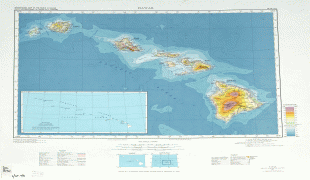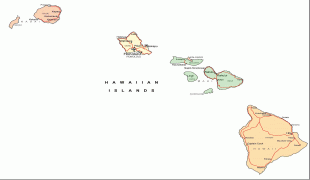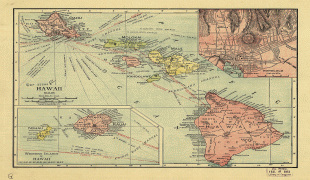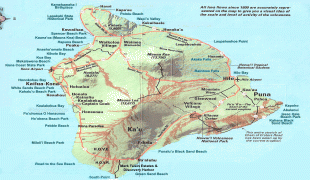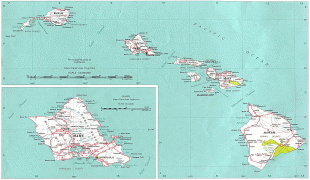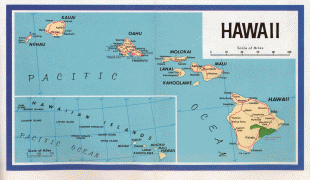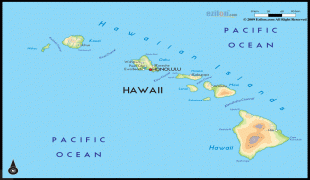Hawaii
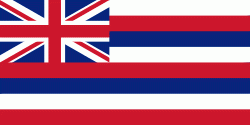 |
 |
Hawaii comprises nearly the entire Hawaiian archipelago, 137 volcanic islands spanning 1500 mi that are physiographically and ethnologically part of the Polynesian subregion of Oceania. The state's ocean coastline is consequently the fourth-longest in the U.S., at about 750 mi. The eight main islands, from northwest to southeast, are Niihau, Kauai, Oahu, Molokai, Lānai, Kahoolawe, Maui, and Hawaii—the last of these, after which the state is named, is often called the "Big Island" or "Hawaii Island" to avoid confusion with the state or archipelago. The uninhabited Northwestern Hawaiian Islands make up most of the Papahānaumokuākea Marine National Monument, the United States' largest protected area and the fourth-largest in the world.
Of the 50 U.S. states, Hawaii is the eighth-smallest in land area and the 11th-least populous, but with 1.4million residents ranks 13th in population density. Two-thirds of the population lives on O'ahu, home to the state's capital and largest city, Honolulu. Hawaii is among the country's most diverse states, owing to its central location in the Pacific and over two centuries of migration. As one of only six majority-minority states, it has the country's only Asian American plurality, its largest Buddhist community, and the largest proportion of multiracial people. Consequently, it is a unique melting pot of North American and East Asian cultures, in addition to its indigenous Hawaiian heritage.
Settled by Polynesians some time between 1000 and 1200 CE, Hawaii was home to numerous independent chiefdoms. In 1778, British explorer James Cook was the first known non-Polynesian to arrive at the archipelago; early British influence is reflected in the state flag, which bears a Union Jack. An influx of European and American explorers, traders, and whalers arrived shortly after leading to the decimation of the once isolated Indigenous community by introducing diseases such as syphilis, gonorrhea, tuberculosis, smallpox, measles, leprosy, and typhoid fever, reducing the native Hawaiian population from between 300,000 and one million to less than 40,000 by 1890.
Hawaii became a unified, internationally recognized kingdom in 1810, remaining independent until American and European businessmen overthrew the monarchy in 1893; this led to annexation by the U.S. in 1898. As a strategically valuable U.S. territory, Hawaii was attacked by Japan on December 7, 1941, which brought it global and historical significance, and contributed to America's decisive entry into World War II. Hawaii is the most recent state to join the union, on August 21, 1959. In 1993, the U.S. government formally apologized for its role in the overthrow of Hawaii's government, which spurred the Hawaiian sovereignty movement.
Historically dominated by a plantation economy, Hawaii remains a major agricultural exporter due to its fertile soil and uniquely tropical climate in the U.S. Its economy has gradually diversified since the mid-20th century, with tourism and military defense becoming the two largest sectors. The state attracts tourists, surfers, and scientists from around the world with its diverse natural scenery, warm tropical climate, abundance of public beaches, oceanic surroundings, active volcanoes, and clear skies on the Big Island. Hawaii hosts the U.S. Pacific Fleet, the world's largest naval command, as well as 75,000 employees of the Defense Department.
Although its relative isolation results in one of the highest costs of living in the United States, Hawaii is the third-wealthiest state.
The State of Hawaii derives its name from the name of its largest island, Hawaii. A common Hawaiian explanation of the name of Hawaii is that it was named for Hawaiiloa, a legendary figure from Hawaiian myth. He is said to have discovered the islands when they were first settled.
The Hawaiian language word Hawaii is very similar to Proto-Polynesian Sawaiki, with the reconstructed meaning "homeland". Cognates of Hawaii are found in other Polynesian languages, including Māori (Hawaiki), Rarotongan (Avaiki) and Samoan (Savaii). According to linguists Pukui and Elbert, "elsewhere in Polynesia, Hawaii or a cognate is the name of the underworld or of the ancestral home, but in Hawaii, the name has no meaning".
Map - Hawaii
Map
Country - United_States
 |
 |
| Flag of the United States | |
Indigenous peoples have inhabited the Americas for thousands of years. Beginning in 1607, British colonization led to the establishment of the Thirteen Colonies in what is now the Eastern United States. They quarreled with the British Crown over taxation and political representation, leading to the American Revolution and proceeding Revolutionary War. The United States declared independence on July 4, 1776, becoming the first nation-state founded on Enlightenment principles of unalienable natural rights, consent of the governed, and liberal democracy. The country began expanding across North America, spanning the continent by 1848. Sectional division surrounding slavery in the Southern United States led to the secession of the Confederate States of America, which fought the remaining states of the Union during the American Civil War (1861–1865). With the Union's victory and preservation, slavery was abolished nationally by the Thirteenth Amendment.
Currency / Language
| ISO | Currency | Symbol | Significant figures |
|---|---|---|---|
| USD | United States dollar | $ | 2 |
| ISO | Language |
|---|---|
| EN | English language |
| FR | French language |
| ES | Spanish language |







